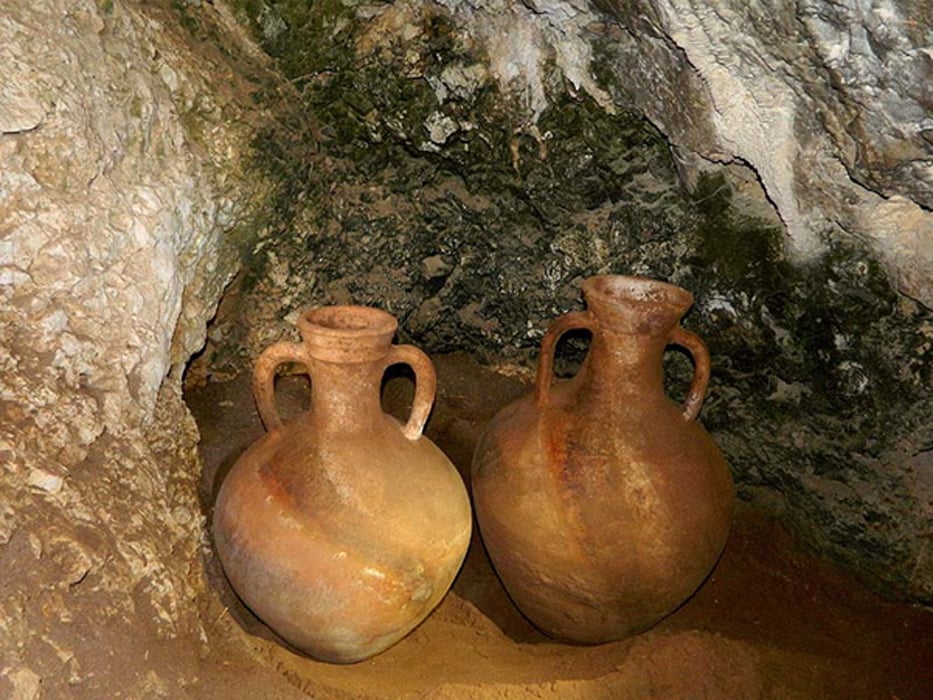Remote Israeli Cave Holds A Potted Mystery
Two ancient jars dated to over 2000-years-old are mystifying archaeologists, as they were lowered down an “almost totally inaccessible... sheer 30 meter cliff-face” and stashed inside a tiny cave in Israel, right on the border with Lebanon.
Baffled by how these pots might have got there, Dr. Yinon Shavtiel, a speleologist from the Safed Academic College, told reporters at Haaretz that “Somebody had to be terrified to reach and hunker down in that inaccessible hole in the sheer cliff.” Even though these pots were ancient cookware, the team of experts told reporters that, “nobody could possibly have lived in the hole” and that getting the jars into the cave wouldn’t have been an easy task.

Climbing with ropes to reach the cave. (Image: Yoav Negev, courtesy Israel Antiquities Authority)
The cave was discovered last summer by Dr. Yinon Shivtiel, who has surveyed caves around Galilee for 20 years, documenting the hideouts of Jewish rebels during the Great Jewish Revolt (66-70 AD). “Hiding from dedicated Roman warriors,” said Shivtiel, required hideouts located off the beaten track, which describes the desolate location of this tiny cliff face hole perfectly.
According to a report in The Jewish Press, the salvage of the fragile, 2,000 year old find was made possible with, “the cooperation of Vladimir Boslov and Boaz Langford of the Israel Cave Research Center of the Hebrew University in Jerusalem, as well as volunteers from the Israel Cave Explorers Club” and the excavation was permitted by the Israel Nature and Parks Authority, with assistance from the Israeli military and the Israeli Antiquities Authority.
Archaeological investigations at this curious cave have just begun and, “carbon-14 dating will likely happen but hasn't yet – but it is already known that the findings have nothing to do with the Great Revolt,” Shivtiel told Haaretz, and the pottery type indicates that it was, “placed in the cave centuries before the great revolt of 70, when the Romans vanquished the Jews.
- Archaeologists unearth 2,000-year-old Roman Legion outpost that controlled Jewish uprisings
- Ancient Jewish necropolis in Israel given worldwide recognition
- 2,400-Year-Old Goddess Statues Found Dumped in Ancient City on Lebanon’s Coast

Dr Danny Syon (right) and Dr Yinon Shivtiel in the cave. Image: Omri Gaster / Israel Antiquities Authority
Dr. Danny Syon of the IAA told reporters, "Considering that cooking and serving vessels were found, it would appear that those who brought them planned to live there for a while,” but Shivtiel is convinced that nobody lived in the cave because it’s “only about 1x2 meters square [3.3x6.6 ft],” and, “You can't climb into that cave," he explains. “It's 30 meters [98ft] above the ground and the cliff face up to it is absolutely sheer."
So what then might these pottery vessels, including jars used to store wine and olive oil have been doing there? Shivtiel theorizes that, “people in stress were hiding in other caves in the area. This one served as a sort of storage cave for food.” What strikes me as curious here is that more often than not when artifacts are discovered with no rational explanation they get hurled into that great big archaeological catch-all ‘ritualistic or ceremonial.” Why then, not here?
- Ancient tablet dedicated to Emperor Hadrian may explain mystery of Jewish revolt
- The Sicarii: The Jewish Daggermen With a Thirst for Roman Blood
- Inscribed Curse on the Sarcophagus of King Ahiram Displays Earliest Use of Phoenician Alphabet

The vessels have not yet been assigned as ‘ritual’: Omri Gester / Israel Antiquities Authority
Only last year Haaretz published the findings of Prof. Dani Nadel from the University of Haifa, and his colleagues, from the Raqefet cave in Mt. Carmel in Israel, that proved “The earliest evidence of using flower beds for burial” began some 13,700 years ago! And, they provided evidence of the widespread use of plants during cave burial rituals.”
Might it be the case that the two pots found in the “almost impossible cliff face” contained plants? And that this cave was used for ritual purposes? And while it was common for priests to choose hard to reach places for meditation, prayer and worship, who is to say a wooden scaffolding didn’t make access relatively easy when the cave was in use?
My speculations, like all others, will soon find judgement as the tests results come in. Where some will be hoping for evidence of food to support their habitation, or survival cave theories, I will be looking for signs of Phytoliths, those resilient, microscopic siliceous plant particles that live on long after a plant decomposes.
And finally, it would not come as surprise to me if they find that the pots contained plants used for burning as incense, another custom in ancient Israel which required pots, and which might lend reason to this otherwise “pointless” discovery! You can read up on the burning of incense in ancient Israel here, in this Journal Article.
Top image: Two of the jugs excavated from the hard to reach cave on the Israeli/Lebanon boarder. Source: Yinon Shivtiel / Israel Antiquities Authority
By Ashley Cowie

















